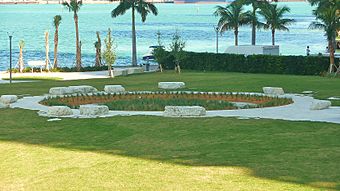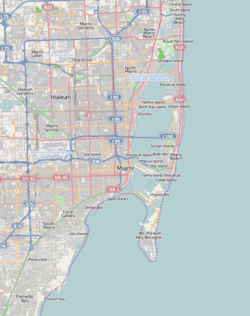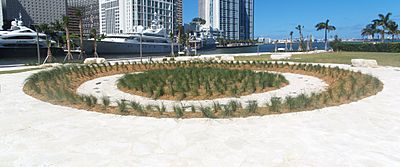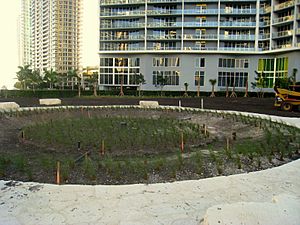Miami Circle facts for kids
|
The Miami Circle at Brickell Point Site
|
|

Miami Circle Park, 7 March 2011
|
|
| Location | Miami, Florida |
|---|---|
| Built | 500 B.C. – A.D. 900 |
| NRHP reference No. | 01001534 |
Quick facts for kids Significant dates |
|
| Added to NRHP | February 5, 2002 |
| Designated NHL | January 16, 2009 |
The Miami Circle is a special archaeological site in Miami, Florida. It's also known as The Miami River Circle or Brickell Point. This site features a perfect circle, about 38 feet (11.5 meters) wide, made of 600 holes or basins cut into the solid limestone ground.
This unique circle is the only known example of a prehistoric permanent structure carved into bedrock in the Eastern United States. It was built long before other known permanent settlements in the area. Experts believe the Tequesta (also called Tekesta) Indians created it. This might have been the location of their main village or capital.
The Miami Circle was found in 1998. It is thought to be between 1,700 and 2,000 years old. In March 2008, HistoryMiami (then called the Historical Museum of Southern Florida) took over the site. They planned to offer tours starting in 2009.
The site was added to the National Register of Historic Places on February 5, 2002. It was then named a National Historic Landmark on January 16, 2009. In 2014, more ancient holes were found nearby, showing even more signs of early human life in Downtown Miami.
Contents
Discovery of the Circle
The land at 401 Brickell Avenue used to have an apartment building. In 1998, a property developer named Michael Baumann bought the site. He planned to build new luxury homes. Before building, city rules said he needed to have an archaeological field survey done. This survey helps find any historical items underground.
Bob Carr, who was in charge of historic preservation for Miami-Dade County, made sure this survey happened. John Ricisak from the same division, along with many volunteers, started digging. They carefully looked for any signs of the past.
During their digging, the team found many holes cut into the limestone bedrock. A surveyor named Ted Riggs noticed that these holes seemed to form a circle. He figured out where the center of the circle would be. Then, he predicted where the other holes should be. When they dug there, they found 24 holes forming a perfect circle in the rock!
The team also found many artifacts in the soil. These included tools made from shells, stone axe-heads, human teeth, and charcoal from old fires.
Studying the Past
All the artifacts found at the Miami Circle site are kept and displayed at HistoryMiami. This museum is the official place for all archaeological finds from Miami-Dade County.
How Old is the Circle?
To find out how old the site was, pieces of burnt wood were sent for testing in 1999. This test is called radiocarbon dating. It helps scientists figure out the age of old materials. The results were surprising: the wood was between 1,800 and 2,000 years old!
Some experts, however, wondered if the circle itself was as old as the wood. More evidence came from geologists Tom Scott and Harvey Means. They pointed to a hard, crusty layer called "duricrust" that had formed on the edges of the cut holes. While this isn't a super precise way to date things, it showed that the holes were definitely very old, not made recently.
Who Built the Circle?
At first, some people thought the circle might have been built by the Olmec or Mayan civilizations from Central America. This was because there wasn't much proof of Native American groups in North America building such permanent structures 2,000 years ago.
However, no artifacts from Central America were found. Instead, the tools made from shells, shark teeth, and other items from the ocean matched perfectly with artifacts known to belong to a local tribe called the Tequesta.
The Tequesta were a Native American tribe who lived in Florida. They were known for hunting fish and alligators in the Florida Everglades. Like many other Native Americans, the Tequesta faced challenges when European colonists arrived. They suffered from new diseases and conflicts.
What Was the Circle For?
Randolph Widmer, a researcher from the University of Houston, suggested that the holes were for posts. These posts would have supported a structure, possibly a cone-shaped building with an opening at the top. Similar buildings were known in the Eastern United States, but none had such a strong, permanent base like the Miami Circle.
Some people wondered why there was no sign of fire on the bedrock, which is usually found in old buildings. Widmer suggested that because Florida often floods, the Tequesta might have built their structure on stilts (raised posts). This would keep the building dry. He also thought that the groups of holes might be places where posts were replaced over time as the wood rotted.
Researchers then tried to figure out the building's purpose. Was it a home or a special ceremonial building? The lack of evidence for it being a home suggested it was likely a ceremonial place. Building such a structure would have required a lot of teamwork, especially with simple tools. This kind of teamwork is often seen when people build religious or important community buildings.
There were also some unusual items found at the site. Many common Tequesta items were there, like tools and decorations made from shells and shark teeth. But a few items didn't fit. The most important were two axe heads made of basalt stone. This type of hard stone was very rare in southern Florida. What was even more interesting was that these axe heads looked completely unused. Dr. Jacqueline Dixon from the University of Miami found that the basalt likely came from Macon, Georgia, which is about 600 miles (965 kilometers) away!
Other special items found included a complete 5-foot (1.5-meter) long shark skeleton, a dolphin skull, and a full sea-turtle shell. Four human teeth were also found, but there was no other evidence that it was a burial site. These special items suggest the circle was a very important place for the Tequesta people.
Miami Circle Park
A park next to the water, managed by HistoryMiami, opened in 2011. The actual Miami Circle remains buried underground to keep it safe. However, visitors can take an audio tour and read several information panels that describe the circle and its history.
Images for kids
See also
 In Spanish: Miami Circle para niños
In Spanish: Miami Circle para niños









